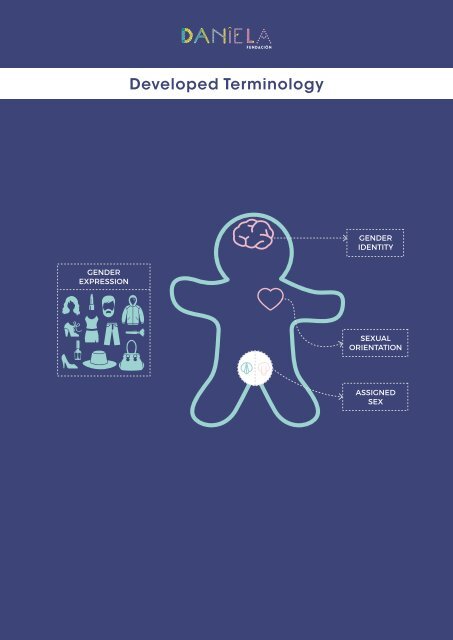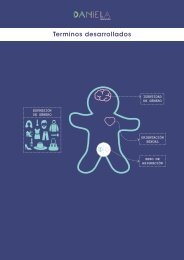terminos_english
You also want an ePaper? Increase the reach of your titles
YUMPU automatically turns print PDFs into web optimized ePapers that Google loves.
Developed Terminology<br />
GENDER<br />
IDENTITY<br />
GENDER<br />
EXPRESSION<br />
SEXUAL<br />
ORIENTATION<br />
ASSIGNED<br />
SEX
Discover<br />
Developed terminology<br />
1<br />
Cisgender people<br />
-<br />
Those whose gender identity coincides with their biological sex.<br />
2<br />
Intersex people:<br />
-<br />
Intersex is the condition of a person who simultaneously shows both male and female sexual characteristics in<br />
different levels or a lack of definition of the genitals, making it impossible to define them according to the dichotomous<br />
classifications. The person may have a vaginal opening that may be partially joined or fits into the vaginal<br />
fornix to an erectile organ (penis or clitoris) that can be more or less developed and testicles, which tend to be<br />
internal.<br />
3<br />
Transgender people*:<br />
-<br />
Those whose gender identity is different from their assigned sex. Usually, trans people begin their transition process<br />
in order to make their body be in line with the sex they feel they are. It was not until recently that talking about<br />
transsexual and transgender children was taboo, but this has become a reality in the present. Trans people don’t<br />
become trans in their adulthood, as, in many cases, it can start when they are a child. It is essential to respect their<br />
gender expression and identity from a very young age to guarantee their physical and mental health.<br />
4<br />
Biological sex:<br />
-<br />
A combination of sexed elements in the body, which is mainly defined upon birth by the chromosomal sex: XX in<br />
the case of females and XY in the case of males. The biological sex can also be identified through the primary<br />
sexual characteristics (penis/vulva, testicles/ovaries) or the secondary characteristics during puberty (voice<br />
change, growing breasts, menstruation, etc.)<br />
5<br />
Asigned Sex:<br />
-<br />
The sex that is established on a newborn by identifying its external genitals, considering that if you are born with<br />
a vulva you are a girl and with a penis you are a boy.
Discover<br />
Developed terminology<br />
6<br />
Sexual Orientation:<br />
-<br />
The American Psychological Association (APA) defines it as a romantic, sexual and/or lasting emotional attraction<br />
towards others. It becomes noticeable during puberty/adolescence, which is a much later age compared<br />
to gender identity. It does not necessarily have to be linked to either gender identity or gender roles.<br />
7<br />
Gender Identity:<br />
-<br />
The perception an individual may have on him/herself regarding if they feel like a man, a woman or a combination<br />
of both or none. In other words, granting oneself with a sex and an identity. The gender identity can coincide<br />
or not with the sex assigned at birth. Although most people develop a gender identity that coincides with their<br />
biological sex, for some it is different from their biological or assigned sex. Many writers have shown that children<br />
are able to identify their physiological differences with other genders as early as when they are two years old,<br />
and when they are three year old any child knows how to differentiate their gender from others. Such identity, as a<br />
young child, is built based on the comparison of their individual characteristics with cultural rules or stereotypes<br />
associated to a specific gender within their society.<br />
8<br />
Gender Expression / Gender Roles:<br />
-<br />
A set of social and behavior standards that society establishes as appropriate or inappropriate according to the<br />
gender each person has related to a conventional gender system. In other words, an attitude, behavior or game<br />
that we believe to be “for boys or for girls” according to our upbringing. For example, it is believed that a female<br />
gender role plays with dolls or that a male gender role is physically strong.<br />
9<br />
Gender Diversity:<br />
-<br />
This includes the wide range of identities and experiences of a gender, including those that follow traditional stereotypes<br />
and those that lay far from them or are not attached at all. The term is considered to be more inclusive<br />
in regards to other expressions for the same definition.
Discover<br />
Developed terminology<br />
10<br />
Niños con una expresión de género diverso:<br />
-<br />
Children whose gender expression and role fail to meet society’s traditional gender expectations. In other words,<br />
children who to do not follow the traditional gender behaviors believed to be masculine or feminine. Having a<br />
diverse gender expression does not necessarily imply that the child is homosexual, bisexual or transsexual, as it<br />
only states that their roles do not adjust to the standard patterns.<br />
11<br />
Trans* (T*) children and teenagers:<br />
-<br />
Children who maintain a persistent and firm feeling or belief that they do not belong to the sex they have been<br />
assigned and that they should have the other sex. It is likely for a child with diverse gender expression to feel discomfort<br />
and upset with their genitals, to prefer clothing, toys and games associated to the sex they feel identified<br />
with and to prefer playing with other children of the opposite sex. Some also show deep unhappiness with their<br />
biological sex, even from a very young age. It is important to highlight that such description could vary from one<br />
age to another regarding its strength or agitation.<br />
12<br />
Homofobia<br />
-<br />
A behavior of rejection and dislike towards homosexuality and homosexuals. Nonetheless, the terms is also used<br />
in its general sense to talk about an attitude towards lesbians, bisexuals and transsexuals (LGBTphobia), which<br />
would be incorrect as it makes the diversity within the LGBT group invisible. Should we be making reference to<br />
the rejection and dislike towards lesbian women, the correct term would be lesbophobia, biphobia when talking<br />
about bisexuals, or transphobia when talking about transsexuals.<br />
It’s important to understand that LGBTphobia is based on the stigma associated to those who belong to this<br />
group and the social preconceptions attached. Many writers have confirmed that the more visible it is that a<br />
person belongs to a stigmatized community, the more discrimination they will feel. That is to say, the more obvious<br />
it is that you are LGBT, the higher the risk of feeling excluded.<br />
Gays, lesbians and bisexuals can choose, whether it be harder or easier, to make their sexual orientation obvious<br />
or not, while a transsexual is physical proof of their transition process. This visibility that they have not chosen and<br />
often times faced by transsexuals leads to believe that such a community suffers most discrimination in Europe,<br />
beyond that suffered by Romanian Gypsies, who used to be first on the list.<br />
This proves that, presently, transphobia is considered to be one of the main problems that our society must deal<br />
with in order to achieve a fair and equal society for everyone.
Discover<br />
Developed terminology<br />
13<br />
LGBTIQ:<br />
-<br />
Acronym that includes: lesbian, gay, bisexual, transsexual, intersex and questioning individuals.<br />
14<br />
Gender Dysphoria:<br />
-<br />
The DSM V (Diagnostic and Statistical Manual of Mental Disorders) defines gender dysphoria as the inconsistency<br />
between the felt gender and the assigned gender. The term gender dysphoria had been used in the past as<br />
a synonym for transsexualism, but in the present day it would be incorrect as it is a pathological term. Dysphoria<br />
is the opposite of euphoria, meaning disgust, misalignment or discomfort. Gender dysphoria is, therefore, related<br />
to the discomfort and psychological consequences caused by living in a body different from its gender identity<br />
or the social difficulties that can be caused by social transphobia. Not all transsexual children suffer from gender<br />
dysphoria, as it may not present itself depending on the environment they have created or the relationship they<br />
have with their body.<br />
15<br />
Transition Process:<br />
-<br />
The transition process is known as the process that some transsexuals wish to endure in order to match their gender<br />
expression with their gender identity. Said process must begin whenever each individual person believes they<br />
must do so and when they are ready to take that step.<br />
Those who do the transition usually begin by expressing their preferred gender in situations where they feel safe<br />
to do so. Generally, there are many gradual changes before they live fully as members of the preferred gender<br />
community. There is no “right” or “full” way of doing a transition from one gender to the other. There are some common<br />
social changes experimented by transsexuals that can include one or more of the following: adopting the<br />
physical appearance of the desired gender by means of changing the way they dress, adopting a new name,<br />
changing the designated sex on personal ID documents (if possible), applying hormone treatment or undergoing<br />
medical procedures that change physical characteristics corresponding to the gender identity.<br />
Luckily, our present society has learnt more about transsexualism and such processes take place at an earlier<br />
stage. A few years ago, to talk about trans identities in children was taboo, but nowadays many boys and girls can<br />
start their transition process to their true gender identities at an earlier stage.<br />
A single pattern cannot be defined during such transition as each individual does it in their own time when they<br />
feel ready and up to the point they wish.
Discover<br />
Developed terminology<br />
16<br />
Transsexual Man:<br />
-<br />
Those who were assigned a female gender when they were born but identify with a male gender. They are also<br />
known with the acronym F+M.<br />
17<br />
Transsexual Woman:<br />
-<br />
Those who were assigned a male gender when they were born but identify with a female gender. They are also<br />
known with the acronym M+F.<br />
18<br />
Hormone Inhibitors / Puberty Blockers:<br />
-<br />
A drug treatment which aims at stopping the development of secondary sexual characteristics during puberty<br />
and adolescence. It is not an irreversible treatment as it continues the normal pubertal development when you<br />
stop taking the treatment. This treatment is given to trans (*) children to avoid their bodies from developing characteristics<br />
that differ from their gender identity.<br />
19<br />
Hormone Treatment:<br />
-<br />
The treatment transsexuals undergo in order to make their bodies develop secondary sexual characteristics corresponding<br />
to their sexual identity.<br />
20<br />
Masculinization of the chest:<br />
-<br />
The surgical technique by which the glandular breast tissue is removed. The surgery aims to make the chest flat<br />
and symmetric, giving it an anatomic and masculine appearance.
Discover<br />
Developed terminology<br />
21<br />
Hysterectomy and Adnexectomy:<br />
-<br />
The surgical technique by which the womb and the ovaries are removed. This intervention aims to avoid the effect<br />
feminine hormones have on ovaries, as well as any possible disorder that may take place in the internal feminine<br />
genitals, which seem to be strengthened when taking masculine hormones. It is the previous step to the sex<br />
reassignment (SRS).<br />
22<br />
Sex Reassignment Surgery<br />
-<br />
The objective of this surgery is to adapt the external genitals of transsexuals to their gender identity.<br />
23<br />
Queer:<br />
-<br />
A term used by some who identify their gender outside the gender binary of “man” and “woman”. They may<br />
define their gender within a scale between man and woman or define it as something completely different from<br />
these terms. They may also wish to be named or called upon with neutral pronouns that are neither masculine<br />
nor feminine, such as “it” instead of “him” or “her”. Some queer-gender people don’t identify themselves as transgender<br />
or transsexual.







